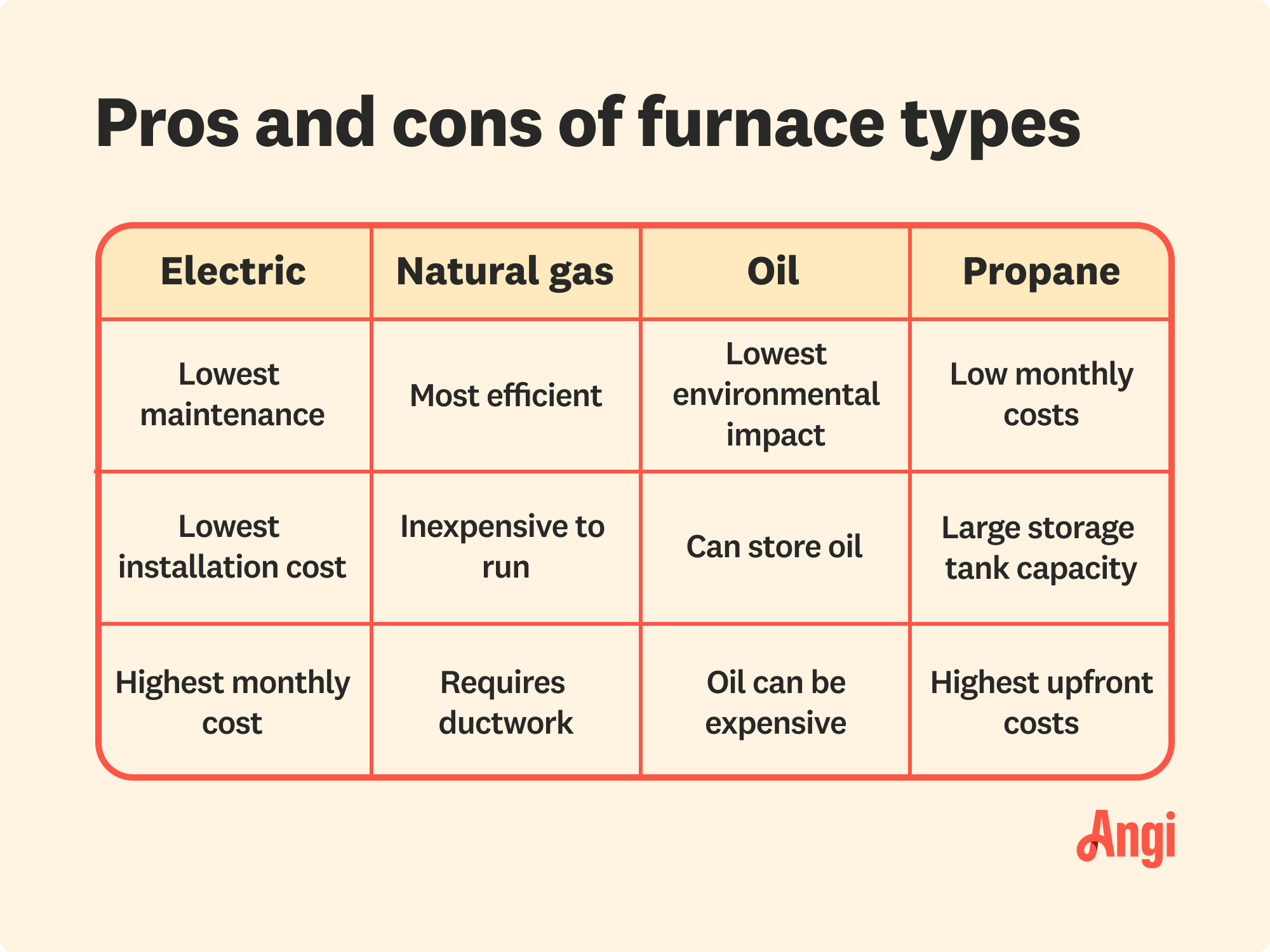How Much Does It Cost to Replace an Oil Furnace With Gas? [2025 Data]
The average cost to convert from an oil furnace to gas is $8,500. Costs range from $5,000 to $12,000 depending on gas lines and ductwork, so only a pro can provide an accurate estimate.


Converting from oil to gas can save you an average of $950 yearly on heating costs.
Your HVAC professional will determine the conversion cost by considering your furnace type, gas line installation, and ductwork design.
You can choose between a natural gas and a propane gas furnace.
Labor will account for between 20% and 30% of the total cost, though most professionals will charge by the hour.
Always hire a trained professional familiar with building codes and local permits before altering your furnace.
It’s no secret that cranking up the heat on a traditional oil furnace is akin to cranking up your utility bill. You can set your sights on long-term energy savings by switching to a gas heating system. The cost to convert from an oil furnace to a gas furnace is $8,500 on average, but it can range from $3,800 for a simple swap to $13,000 for a high-efficiency furnace that requires gas line installation.
As the air gets colder, the warmth of your furnace makes your home inviting and comfortable. This guide helps plan out furnace installation costs so you can cozy up to a more comfortable budget.
Cost Factors for Converting Oil Furnace to Gas
How much does it cost to replace an oil furnace with natural gas? Several different factors impact the price—from the efficiency and quality of your furnace to the scale of your installation. Depending on your home, an HVAC tech may need to install gas lines, a propane tank, ductwork, or a chimney liner along with your furnace. Here are some costs to keep in mind.
| Installation Costs | Average Price Range |
|---|---|
| Furnace | $500–$6,500 |
| Gas line installation | $15–$25 per linear foot |
| Professional labor | $500–$5,000 |
| Propane tank installation | $600–$2,500 |
| Oil tank removal and disposal | $50–$600 |
| Permits | $50–$300 |
| Chimney liner installation | $500–$2,000 |
| Ductwork | $500–$1,500 |
Type and Efficiency of Gas Furnace
For most homeowners, a new gas furnace costs $700 to $6,500 before labor. Choosing the right model is a balance of the up-front cost and the long-term savings you’ll get on your energy bill from increased efficiency. There are three types of furnaces to choose from:
| Type of Furnace | Average Cost |
|---|---|
| Single-stage | $500–$3,000 |
| Two-stage | $1,000–$3,500 |
| Modulating | $1,300–$6,500 |
Single-stage furnace: Single-stage furnaces cost $500–$3,000. This type of furnace doesn’t have nuanced controls, meaning it’s either on at full power or completely off, and it’s the least efficient option.
Two-stage furnace: Two-stage furnaces are moderately efficient and cost $1,000–$3,500. This type of furnace has a high blower for colder days and a low blower for warmer days.
Modulating furnace: Modulating furnaces are the most efficient and cost $1,300–$6,500. This type of furnace can continuously adjust the heat output and airflow to maintain a consistent temperature.
According to the U.S. Department of Energy, every furnace has an Annual Fuel Utilization Efficiency (AFUE) rating to help you understand how well it burns fuel. High-efficiency models (such as modulating furnaces) have the highest price tag and an AFUE rating of 96% or above. The lowest efficiency models (such as single-stage furnaces) have the lowest price tag and an AFUE rating between 80% and 89%.
Gas Line Installation
A gas line installation costs $20 per linear foot on average. During your furnace installation, your contractor may need to install gas lines in your home. If your home isn’t connected to the municipal grid, they may need to extend the line from the street to your house.
Labor
Labor makes up 20% to 30% of the cost of replacing an oil furnace with a gas furnace. You can expect to spend anywhere from $500 to $5,000 on labor for a furnace installation. The overall cost depends on the extent of the job, but most contractors charge $50 to $100 per hour.
Propane Tank Installation
The cost to install a propane tank is $1,400 on average, but most homeowners spend between $600 and $2,500. While many furnaces are powered by natural gas that runs from the street into the home, it’s not always convenient or possible to connect to the municipal grid. In this case, you can power a gas furnace with propane, but you’ll need to install a propane tank. This is a common option for homes in rural or remote areas.
Expect costs to rise for an underground propane tank, which will require excavation.
Oil Tank Removal and Disposal
When you replace your oil furnace with a gas furnace, you’ll need to remove and dispose of the old furnace and oil tank. These costs range from $50 and $600 and are usually included in your contractor’s estimate.
Permits
In most areas, you’ll need a permit to install a new gas furnace. Permits, which average $50 to $300, help ensure that the installation is up to code. This is crucial when dealing with gas lines and excavation because DIY installation can create a safety hazard.
Additional Modifications
Beyond gas line installation, your home may need a couple of modifications when you switch from oil to gas. Commonly, homeowners will replace chimney liners that are not compatible with natural gas or propane. You may also need to modify your ductwork during installation.
| Modification | Average Cost |
|---|---|
| Ductwork | $500–$1,500 |
| Chimney liner installation | $500–$2,000 |
Oil vs. Gas Furnaces

When you’re talking about furnaces, it’s important to know the distinctions between an oil versus a gas furnace. An oil furnace relies on oil as the fuel source instead of natural gas or propane. Oil fuel is less flammable than natural gas, and you store it in a tank near your home. Overall, oil furnaces cost less but aren’t as energy efficient as a natural gas option. Oil furnaces also require more maintenance than gas furnaces, including regular cleanings.
Natural Gas Furnaces
The gas used in a natural gas furnace is composed of a mixture of methane, propane, butane, and other traces of gases. This mixture is piped into your house, and it requires a gas main located near your home.
While most areas have gas lines, you may need to call your local utility company to be sure one is available. If you’re not near a gas line, you might be able to convince the local gas company to install a gas main if you and enough neighbors in your area agree to use the service.
Propane Gas Furnaces
The fuel used in propane furnaces is propane, which is a by-product of either crude oil or natural gas. It comes in a liquid form, which you’ve most likely seen in large canisters on the outside of your local home improvement store. Propane gas furnaces are designed to convert the liquid form of propane into a gas that works similarly to natural gas.
Once the gas line or propane tank is connected to the furnace, your thermostat will signal to the burner to ignite the natural gas. This will warm the air that enters the furnace, which is sent to the ducts and pushed out into your home, where you and your family can enjoy the reprieve from a cold, winter day.
Pros and Cons of Gas Furnaces

Before deciding whether switching from oil to gas heat is right, get your pen and paper out to start jotting down all the pros and cons that can impact your choice.
Pros of Gas Furnaces
Gas furnaces are beneficial in many ways. Here are a few pros to choosing a gas furnace for your home:
Gas furnaces are more cost-effective: According to the Energy Information Administration (EIA), gas furnaces cost homeowners approximately $750 to keep warm. By comparison, heating oil costs an average of $1,700, and electricity costs around $1,250.
Some gas furnaces are highly efficient: Highly efficient gas furnaces use as much as 98% of the energy used to run the furnace.
Propane and natural gas reduce carbon dioxide emissions: The Clean Air Act lists propane and natural gas as cleaner fossil fuels than gasoline and diesel.
Installing a gas hookup adds versatility to other appliances: Once your home has a gas hookup, you can convert your other appliances (such as your oven, stove, washer, and dryer) to gas, which can save you even more in the long run.
Cons of Gas Furnaces
Gas furnaces come with a few cons that might help you determine whether or not making the switch is right for you. These include the following:
There are high up-front costs: A gas furnace installation for an average 1,600-to-2,000-square-foot house costs between $3,800–$10,000.
Gas furnaces produce carbon monoxide: This invisible and odorless chemical is poisonous, so make sure you have a carbon monoxide detector installed. The best practice is to hire a local pro to tune up your furnace every year.
You might need to pay to have the old furnace removed: If you’re hoping to replace your old furnace, you’ll have to hire a local furnace pro to remove it, which costs $60–$500.
Switching to gas may require changes to your current furnace chimney and hookup: To factor in potential expenses like these, contact an HVAC professional to see what changes you’ll need to make.
You might need a building permit for installation: Building permits vary with location, but if you do need one, they cost between $400–$1,500 on average.
Gas furnaces have a shorter lifespan: Your gas furnace will last for around 15–20 years, whereas electric furnaces last for around 20–30 years.
Hiring a Pro to Install a Gas Furnace
Replacing your oil furnace with a gas furnace is not a DIY job. This particular installation can involve gas line installation, excavation, and electrical work, all of which pose a risk if you don’t know what you’re doing. Instead, you’ll need to hire a furnace installer near you for your furnace installation, which ranges from $500 to $5,000.
To find the best furnace installer, search for an HVAC technician that is certified, licensed, and insured. Always verify their qualifications and check references. It’s a good idea to get quotes from at least three separate contractors so you can understand local pricing. Keep in mind that the best value isn’t always the lowest price. If something seems too good to be true, it usually is.
Is a Gas Furnace Worth It?
So, is it worth spending a few thousand dollars to switch from oil to gas heat? When considering gas furnace savings, you could pay yourself back in just a few years. Compared to oil-burning furnaces, your gas furnace will save you around $950 annually, and compared to electric furnaces, you will save about $500 annually.
At the end of the day, your decision depends on your own personal situation, how complicated making the switch is for your particular home, and how long you plan on staying at your current house.
How Angi Gets Its Cost Data
Home is the most important place on earth, which is why Angi has helped more than 150 million homeowners transform their houses into homes they adore. To help homeowners with their next project, Angi provides readers with the most accurate cost data and upholds strict editorial standards. We extensively research project costs to develop the pricing data you see, so you can make the best decisions for you and your home. We rely on reputable sources, including the U.S. Bureau of Labor Statistics, academic journals, market studies, and interviews with industry experts—all to ensure our prices reflect real-world projects.
Want to help us improve our cost data? Send us a recent project quote to costquotes@angi.com. Quotes and personal information will not be shared publicly.
Frequently Asked Questions
Yes, it’s possible to convert an oil furnace to gas. However, you may have to replace the furnace completely instead of simply converting it. If the original oil furnace has had any type of damage or is older (typically considered over 15 years old), then you will likely need a full replacement versus a conversion.
A few factors determine the amount of time it takes to convert from an oil to a gas furnace, mainly adding in the gas lines, updating your appliances, removing the old oil system, and installing a chimney line. These projects can vary, but you should expect them to take at least two or three days to complete.





- Furnace Repair
- Air Conditioning Repair
- HVAC Repairs
- Furnace Installation
- Wood & Pellet Stove Repair
- Dehumidifier & Humidifier Repair
- Heat Pump Companies
- Swamp Cooler Repair
- Wood Stove Services
- HVAC Companies
- Commercial A/C Repair
- Geothermal Installation
- Air Conditioning Installation
- Boiler Repair
- 24 Hour Furnace Repair
- Geothermal Repair
- Heat Pump Repair
- Humidifier Installation
- Thermostat Repair
- Thermostat Installation
- Nest Installation
- Heating & Cooling
- Heating Repair
- Furnace Cleaning
- Furnace Tune-Up
- HVAC Technicians
- Subcontractors
- Furnace Maintenance
- Plumbing & Heating Companies
- Wood Stove Inspection
- Mini Split Installation
- Wall Heater Repair
- Duct Installers










